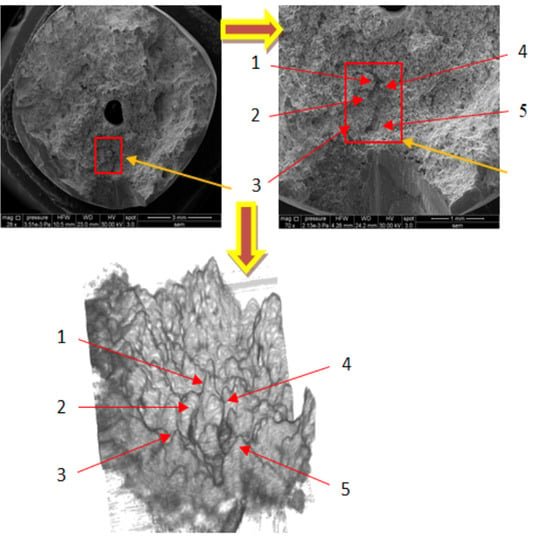Assessment of Ductile, Brittle, and Fatigue Fractures of Metals Using Optical Coherence Tomography
Abstract
:1. Introduction
- First, from the point of view of the investigated samples, whilst in [17] only ductile and brittle fractures were considered (with only three examples), in the present study we investigate a wider range of materials that can be subject to ductile and brittle, but also fatigue fractures. As is well-known, the latter are those that occur most often in applications like those—of forensic type—pointed out above.
- Second, from the point of view of the instruments utilized, in order to be able to tackle with imaging fractures, an in-house developed Master-Slave (MS) powered Swept Source (SS) OCT system was employed. In a first configuration, the OCT instrument was capable to produce images with transversal resolutions similar to the one reported in [17], of around 10 μm (voxel size 103 μm3). In addition, here we also use an (MS)/SS-OCT instrument [23], capable of producing images with a superior transversal resolution, of 4 μm (and an axial resolution of 10 μm, therefore a voxel size of 4 × 4 × 10 = 160 μm3). The instrument is also able to produce volumetric reconstructions of the surface topography by using not cross sections, as is the case with conventional SS-OCT instruments, but en-face images/slices that can also be used to assess fractures by scanning surface grains (in conjunction with the cross sections made through samples). A SEM system with a 4 nm resolution is used to validate all OCT findings.
2. Materials and Methods
2.1. Materials
2.2. Sample Processing Method
2.3. Imaging Methods
3. Results and Discussion
3.1. Ductile Fractures
3.2. Brittle Fractures
3.3. Fatigue Fractures
4. Conclusions
Acknowledgments
Author Contributions
Conflicts of Interest
References
- Goldstein, J.; Newbury, D.E.; Lyman, C.L.; Echlin, P.; Lifshin, E.; Sawyer, L.; Michael, J.R. Scanning Electron Microscopy and X-ray Microanalysis, 3rd ed.; Springer Science + Business Media Inc.: Berlin, Germany, 2003; pp. 128–192. ISBN 978-1-4615-0215-9. [Google Scholar]
- Echlin, P. Handbook of Sample Preparation for Scanning Electron Microscopy and X-ray Microanalysis; Springer Science + Business Media Inc.: Berlin, Germany, 2009; pp. 19–65. ISBN 978-0-387-85731-2. [Google Scholar]
- Williams, D.B.; Carter, C.B. Transmission Electron Microscopy: A Textbook for Materials Science, 2nd ed.; Springer: New York, NY, USA, 1996; pp. 483–509. ISBN 978-0-387-76501-3. [Google Scholar]
- Xia, L.; Shick, C.F. Ductile crack growth. Transition to cleavage fracture incorporating statistics. J. Mech. Phys. Solids 1996, 44, 603–6011. [Google Scholar] [CrossRef]
- Honomura, T.; Yin, F.; Nagai, K. Ductile-brittle transition temperature of ultrafine ferrite/cementite microstructure in low carbon steel controlled by effective grain size. ISIJ Int. 2004, 44, 610–617. [Google Scholar] [CrossRef]
- Ruggieri, C.; Dodds, R.H. A transferability model for brittle fracture including constraint and ductile tearing effects: Probabilistic approach. Int. J. Fract. 1996, 34, 309–340. [Google Scholar] [CrossRef]
- Camacho, G.T.; Ortiz, M. Computation modeling of impact damage in brittle materials. Int. J. Solids Struct. 1996, 33, 2899–2938. [Google Scholar] [CrossRef]
- Tomota, Y.; Xia, Y.; Inoue, K. Mechanism of low temperature brittle fracture in high nitrogen bearing austenitic steels. Acta Mater. 1998, 46, 1577–1587. [Google Scholar] [CrossRef]
- Mullner, P.; Sotenthaler, C.; Uggowitzer, M.P.J.; Speidel, O. Brittle fracture in austenitic steel. Acta Metall. Mater. 1994, 42, 2211–2217. [Google Scholar] [CrossRef]
- Zhang, X.Z.; Knott, J.F. The statistical modeling of brittle fracture in homogenous and heterogeneous steel microstructures. Acta Mater. 2000, 48, 2135–2146. [Google Scholar] [CrossRef]
- Qian, J.; Fatemi, A. Mixed mode fatigue crack growth: A literature survey. Eng. Fract. Mech. 1996, 55, 969–990. [Google Scholar] [CrossRef]
- Ritchie, R.O. Mechanisms of fatigue-crack propagation in ductile and brittle solids. Int. J. Fract. 1999, 100, 55–83. [Google Scholar] [CrossRef]
- Zhang, Z.-F.; Berto, F. Fracture and Fatigue of Engineering Materials. Adv. Eng. Mater. 2016, 18, 1981–1982. [Google Scholar] [CrossRef]
- Pipinato, A.; Bruhwiler, E. Fatigue and fracture. In Innovative Bridge Design Handbook: Construction, Rehabilitation and Maintenance, 1st ed.; Pipinato, A., Ed.; Butterworth-Heinemann: Oxford, UK, 2016; pp. 49–87. ISBN 9780128000588. [Google Scholar]
- Huang, D.; Swanson, E.A.; Lin, C.P.; Schuman, J.S.; Stinson, W.G.; Chang, W.; Hee, M.R.; Flotte, T.; Gregory, K.; Puliafito, C.A.; et al. Optical coherence tomography. Science 1991, 254, 1178–1181. [Google Scholar] [CrossRef] [PubMed]
- Drexler, W.; Liu, M.; Kumar, A.; Kamali, T.; Unterhuber, A.; Leitgeb, R.A. Optical coherence tomography today: Speed, contrast, and multimodality. J. Biomed. Opt. 2014, 19, 071412. [Google Scholar] [CrossRef] [PubMed]
- Hutiu, G.; Duma, V.-F.; Demian, D.; Bradu, A.; Podoleanu, A.G. Surface imaging of metallic material fractures using optical coherence tomography. Appl. Opt. 2014, 53, 5912–5916. [Google Scholar] [CrossRef] [PubMed]
- Jung, W.; Kim, J.; Jeon, M.; Chaney, E.J.; Stewart, C.N.; Boppart, S.A. Handheld optical coherence tomography scanner for primary care diagnostics. IEEE Trans. Biomed. Eng. 2011, 58, 741–744. [Google Scholar] [CrossRef] [PubMed]
- Lu, C.D.; Kraus, M.F.; Potsaid, B.; Liu, J.J.; Choi, W.; Jayaraman, V.; Cable, A.E.; Hornegger, J.; Duker, J.S.; Fujimoto, J.G. Handheld ultrahigh speed swept source optical coherence tomography instrument using a MEMS scanning mirror. Biomed. Opt. Express 2014, 5, 293–311. [Google Scholar] [CrossRef] [PubMed]
- Monroy, G.L.; Won, J.; Spillman, D.R.; Dsouza, R.; Boppart, S.A. Clinical translation of handheld optical coherence tomography: Practical considerations and recent advancements. J. Biomed. Opt. 2017, 22, 121715. [Google Scholar] [CrossRef] [PubMed]
- Demian, D.; Duma, V.-F.; Sinescu, C.; Negrutiu, M.L.; Cernat, R.; Topala, F.I.; Hutiu, G.; Bradu, A.; Podoleanu, A.G. Design and testing of prototype handheld scanning probes for optical coherence tomography. Proc. Inst. Mech. Eng. Part H J. Eng. Med. 2014, 228, 743–753. [Google Scholar] [CrossRef] [PubMed]
- Duma, V.-F.; Dobre, G.; Demian, D.; Cernat, R.; Sinescu, C.; Topala, F.I.; Negrutiu, M.L.; Hutiu, G.; Bradu, A.; Podoleanu, A.G. Handheld scanning probes for optical coherence tomography. Rom. Rep. Phys. 2015, 67, 1346–1358. Available online: http://www.rrp.infim.ro/2015_67_4/A14.pdf (accessed on 1 February 2018).
- Podoleanu, A.G.; Bradu, A. Master–slave interferometry for parallel spectral domain interferometry sensing and versatile 3D optical coherence tomography. Opt. Express 2013, 21, 19324–19338. [Google Scholar] [CrossRef] [PubMed]
- Drexler, W.; Fujimoto, J.G. (Eds.) Optical Coherence Tomography: Technology and Applications; Springer International Publishing: Cham, Switzerland, 2015; ISBN 978-3-319-06420-8. [Google Scholar]
- Wiesauer, A.D.; Dufau, S.; Gotzinger, E.; Pircher, M.; Hitzenberger, C.D.; Stifter, D. Non-destructive quantification of internal stress in polymer materials by polarisation sensitive optical coherence tomography. Acta Mater. 2005, 53, 2785–2791. [Google Scholar] [CrossRef]
- Jonathan, E. Non-contact and non-destructive testing of silicon V-grooves: A non-medical application of optical coherence tomography (OCT). Opt. Lasers Eng. 2006, 44, 1117–1131. [Google Scholar] [CrossRef]
- Czajkowsk, J.; Pryka, T.; Alarousu, E.; Palosaari, J.; Myllyla, R. Optical Coherence Tomography as a Method of Quality Inspection for Printed Electronics Products. Opt. Rev. 2010, 17, 257–262. [Google Scholar] [CrossRef]
- Serrels, K.L.; Renner, M.K.; Reid, D.T. Optical coherence tomography for non-destructive investigation of silicon integrated-circuits. Microelectron. Eng. 2010, 87, 1785–1791. [Google Scholar] [CrossRef]
- Kyotoku, B.B.C.; Gomes, A.S.L. Dental fiber-reinforced composite analysis using optical coherence tomography. Opt. Commun. 2007, 279, 403–407. [Google Scholar] [CrossRef]
- Turki, A.; Bakhsha, B.; Sadrb, A.; Shimadaa, Y.; Junji Tagamia, B.; Yasunori, S. Non-invasive quantification of resin–dentin interfacial gaps using optical coherence tomography: Validation against confocal microscopy. Dent. Mater. 2011, 27, 915–925. [Google Scholar] [CrossRef]
- Stepien, R.; Buczynski, R.; Pysz, D.; Kujawa, I.; Filipkowski, M.M.; Diduszko, R. Development of thermally stable tellurite glasses designed for fabrication of microstructured optical fibers. J. Non Cryst. Solids 2011, 357, 873–883. [Google Scholar] [CrossRef]
- Price, J.H.P.; Feng, X.; Heidt, A.M.; Brambilla, G.; Horak, P.; Poletti, F.; Ponzo, G.; Petropoulos, P.; Petrovich, M.; Shi, J.; et al. Supercontinuum generation in non-silica fibers. Opt. Fiber Technol. 2012, 18, 327–344. [Google Scholar] [CrossRef]
- Liang, H.; Gomez Cid, M.; Cucu, R.G.; Dobre, G.M.; Podoleanu, A.G.; Saunders, D. En-face optical coherence tomography—A novel application of non-invasive imaging to art conservation. Opt. Soc. Am. 2005, 13, 6133–6144. [Google Scholar] [CrossRef]
- Laopornpichayanuwat, W.; Visessamit, J.; Tianprateep, M. 3-D surface roughness profile of 316-stainless steel using vertical scanning interferometry with a superluminescent diode. Measurement 2012, 45, 2400–2406. [Google Scholar] [CrossRef]
- Choi, W.J.; Jung, S.P.; Shin, J.G.; Yang, D.; Lee, B.H. Characterization of wet pad surface in chemical mechanical polishing (CMP) process with full-field optical coherence tomography (FF-OCT). Opt. Express 2011, 19, 13343–13350. [Google Scholar] [CrossRef] [PubMed]
- Hutiu, G.; Duma, V.-F.; Demian, D.; Bradu, A.; Podoleanu, A.G. Analysis of the fractures of metallic materials using optical coherence tomography. In Proceedings of the SPIE Optical Measurement Systems for Industrial Inspection X (Optical Metrology—LASER Congress), Munchen, Germany, 25–30 June 2017; Lehmann, P., Osten, W., Gonçalves, A.A., Eds.; SPIE Press: Bellingham, WA, USA, 2017; Volume 10329. [Google Scholar] [CrossRef]
- Rueden, C.T.; Schindelin, J.; Hiner, M.C.; DeZonia, B.E.; Walter, A.E.; Arena, E.T.; Eliceir, K.W. ImageJ2: ImageJ for the next generation of scientific image data. BMC Bioinform. 2017, 18, 529. [Google Scholar] [CrossRef] [PubMed]
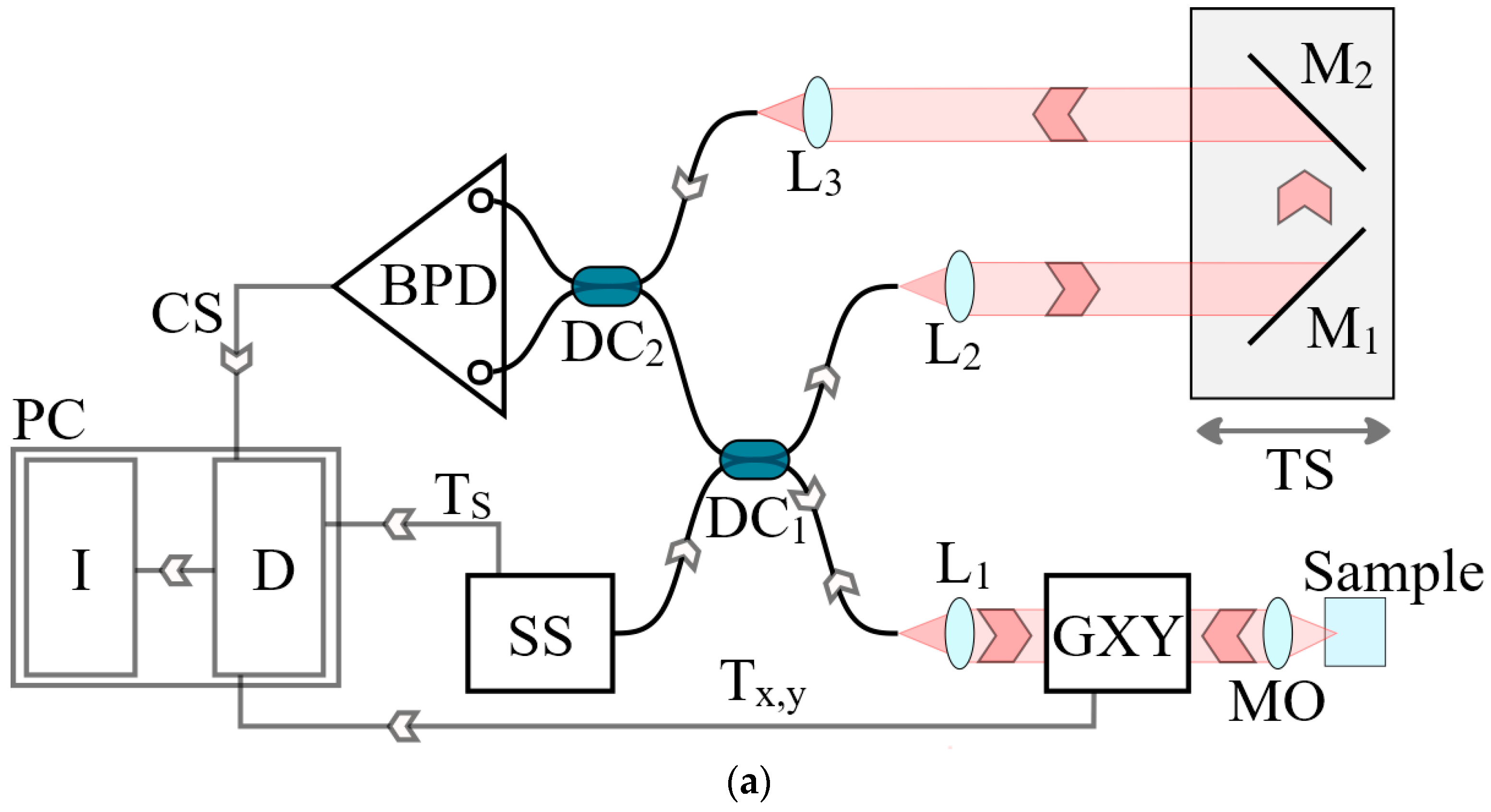
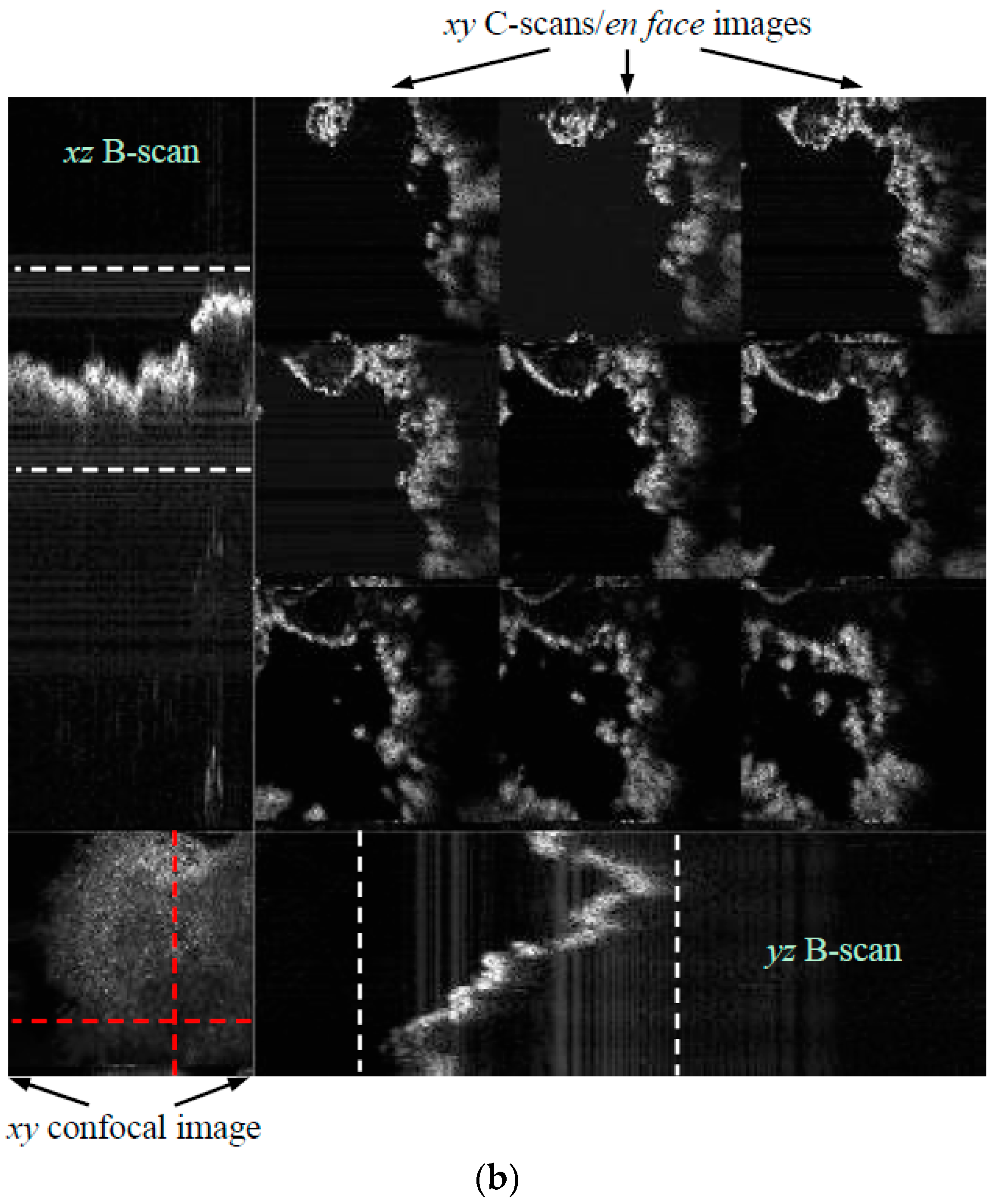

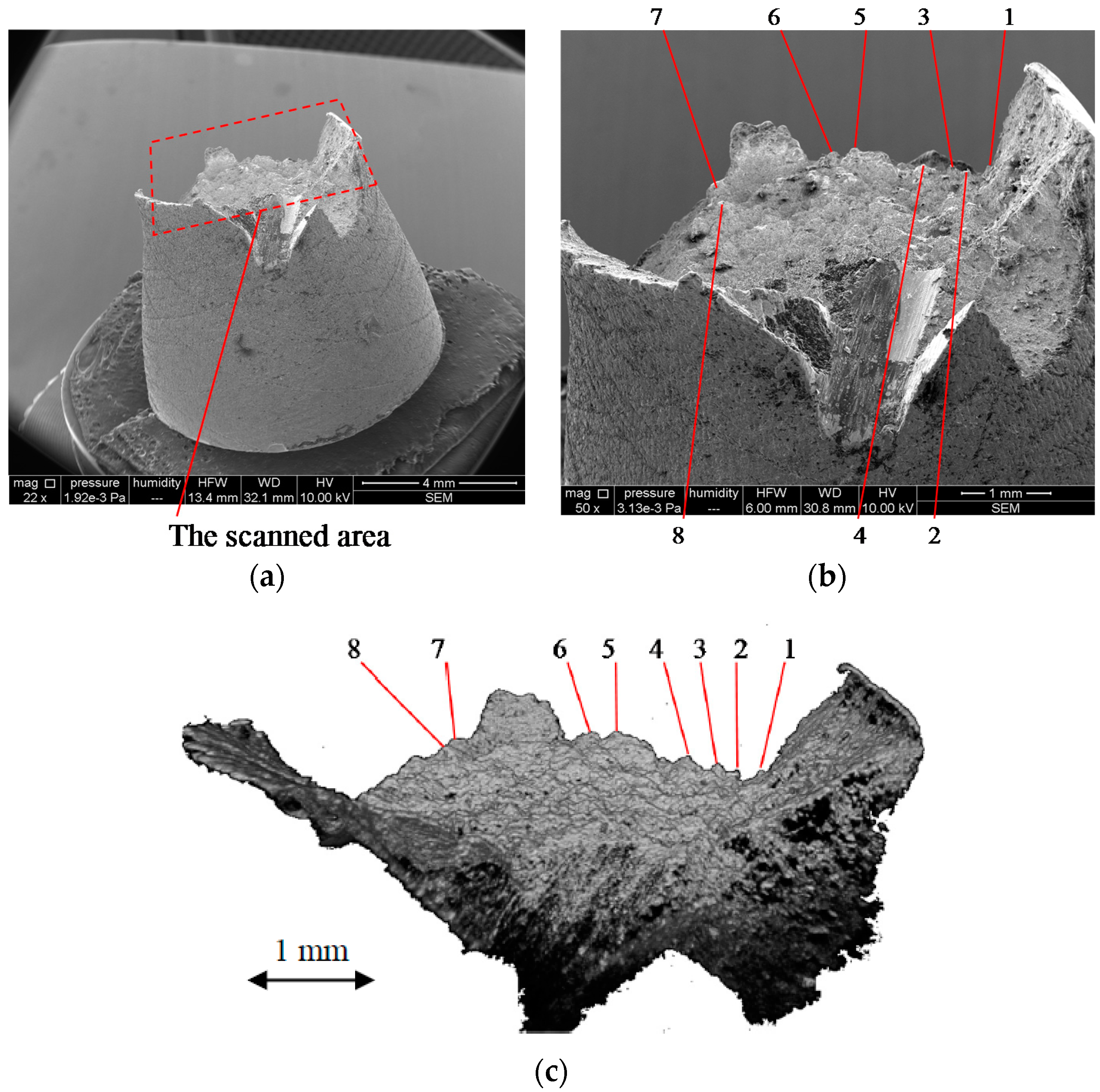
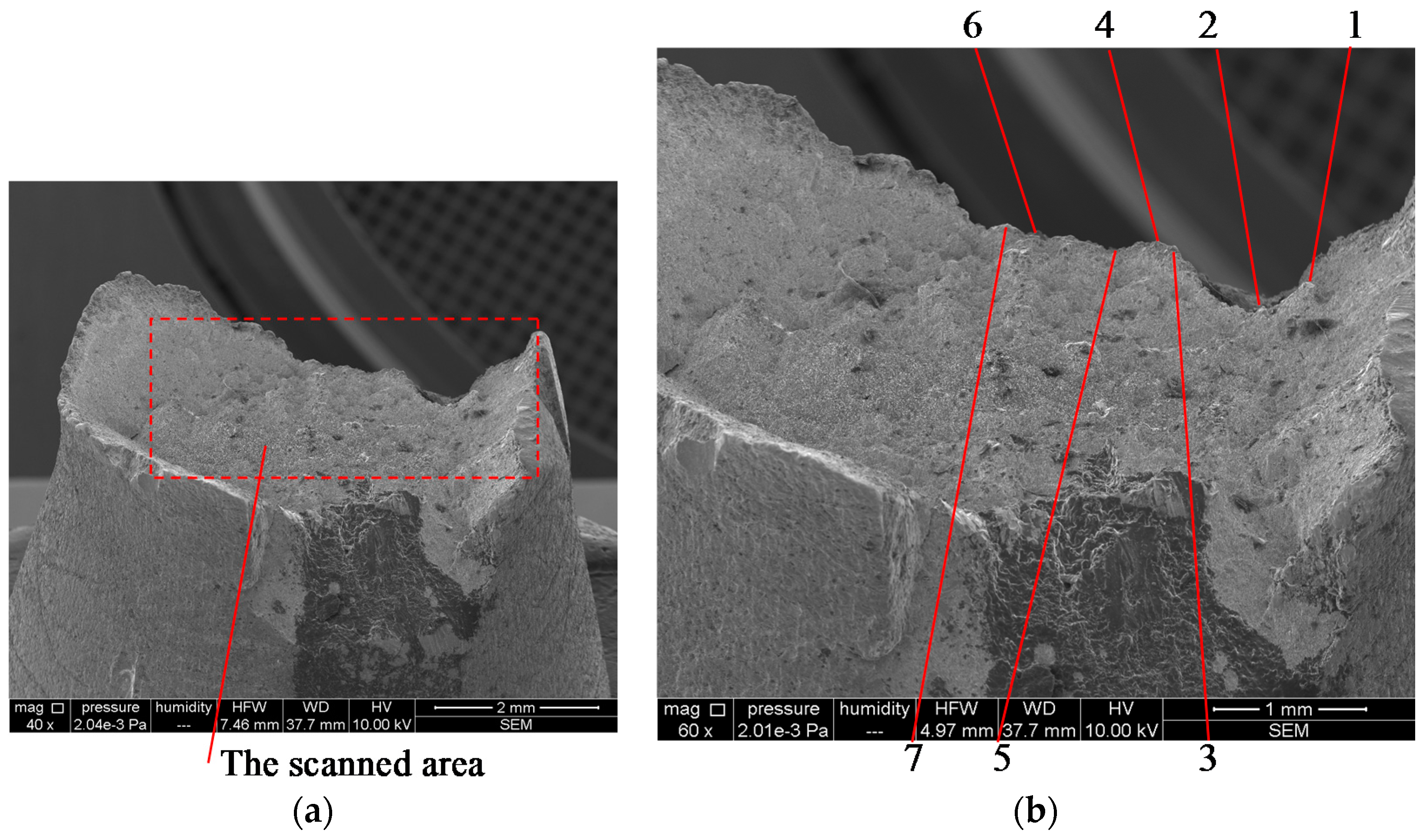

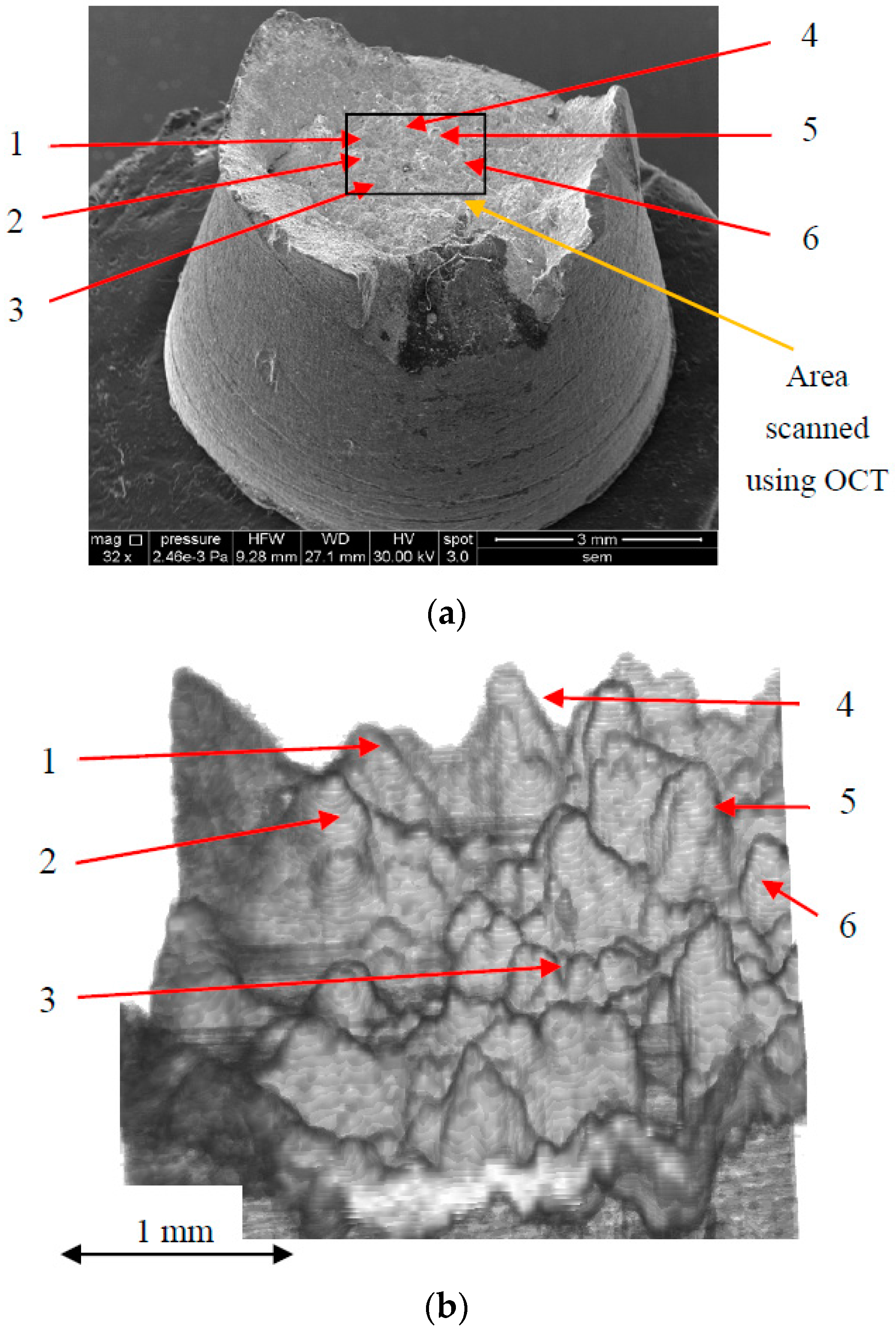
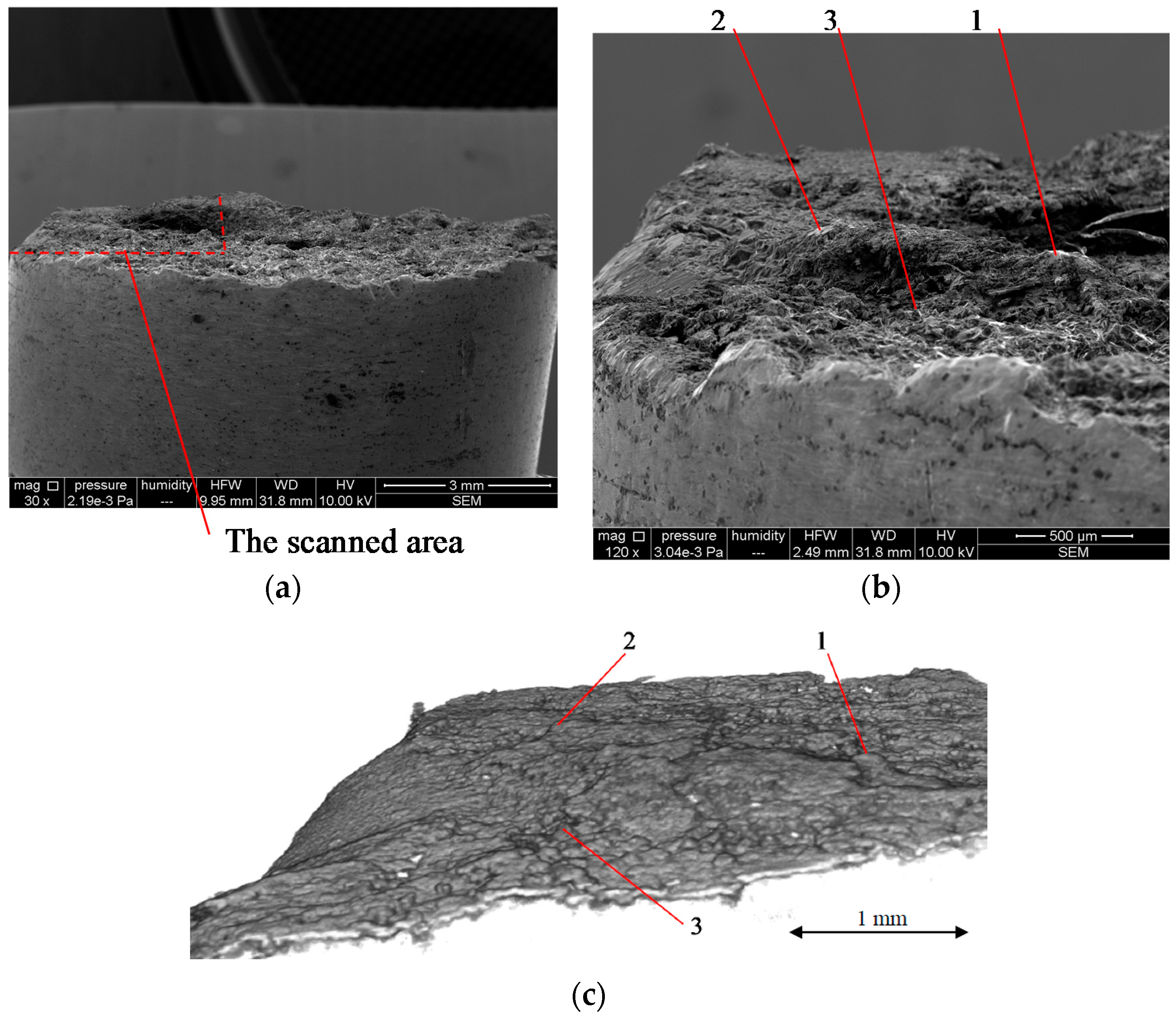
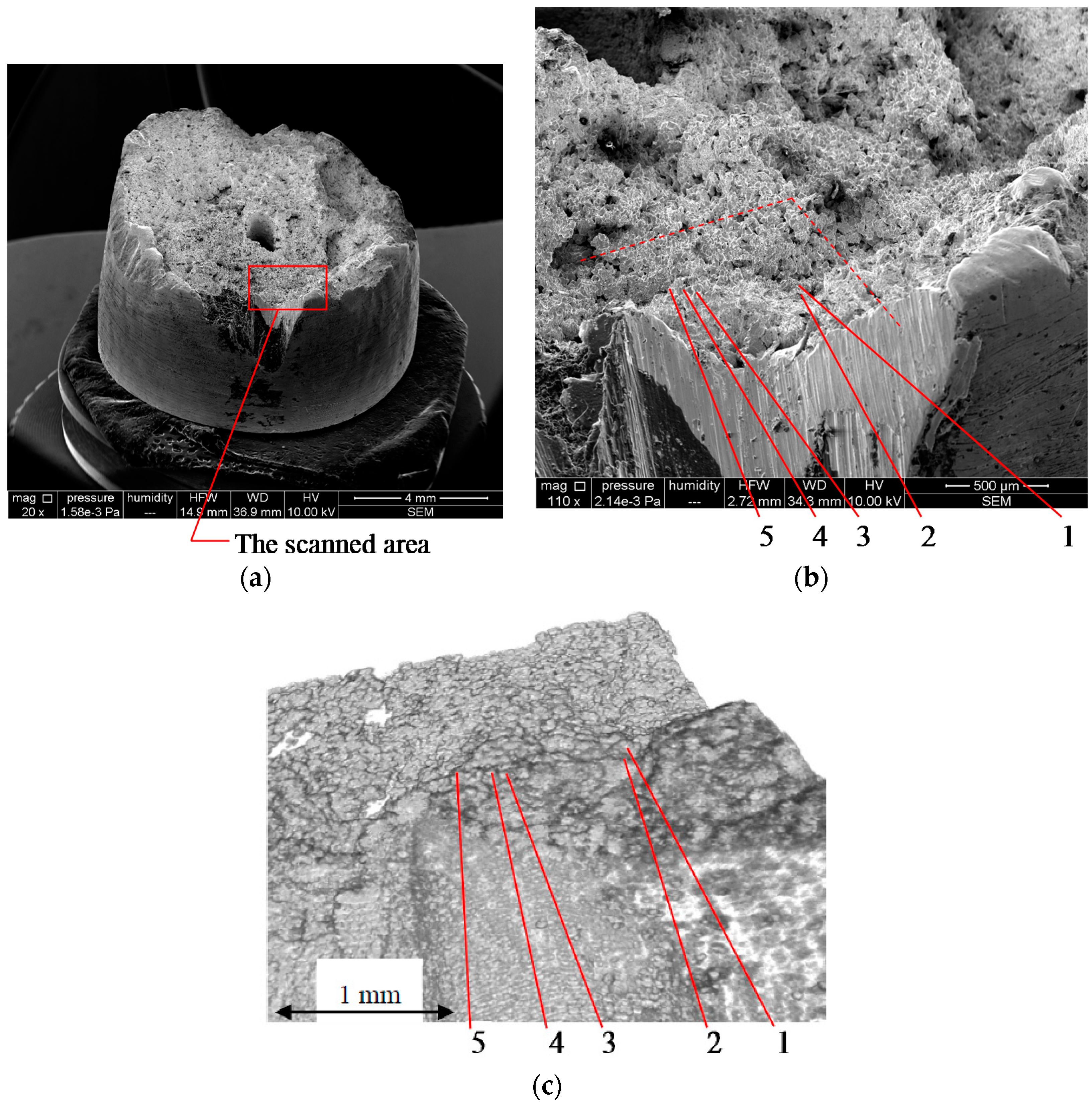
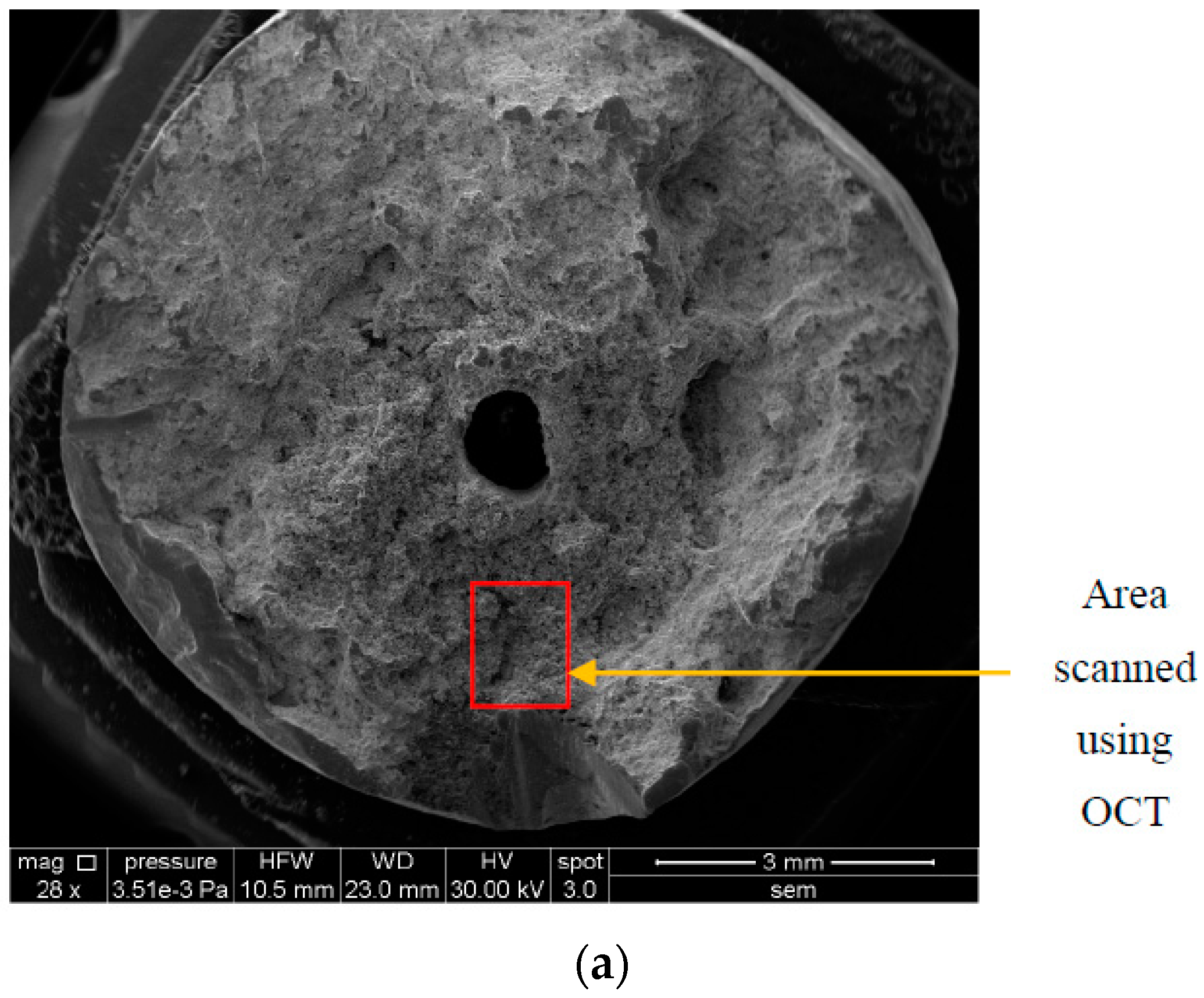
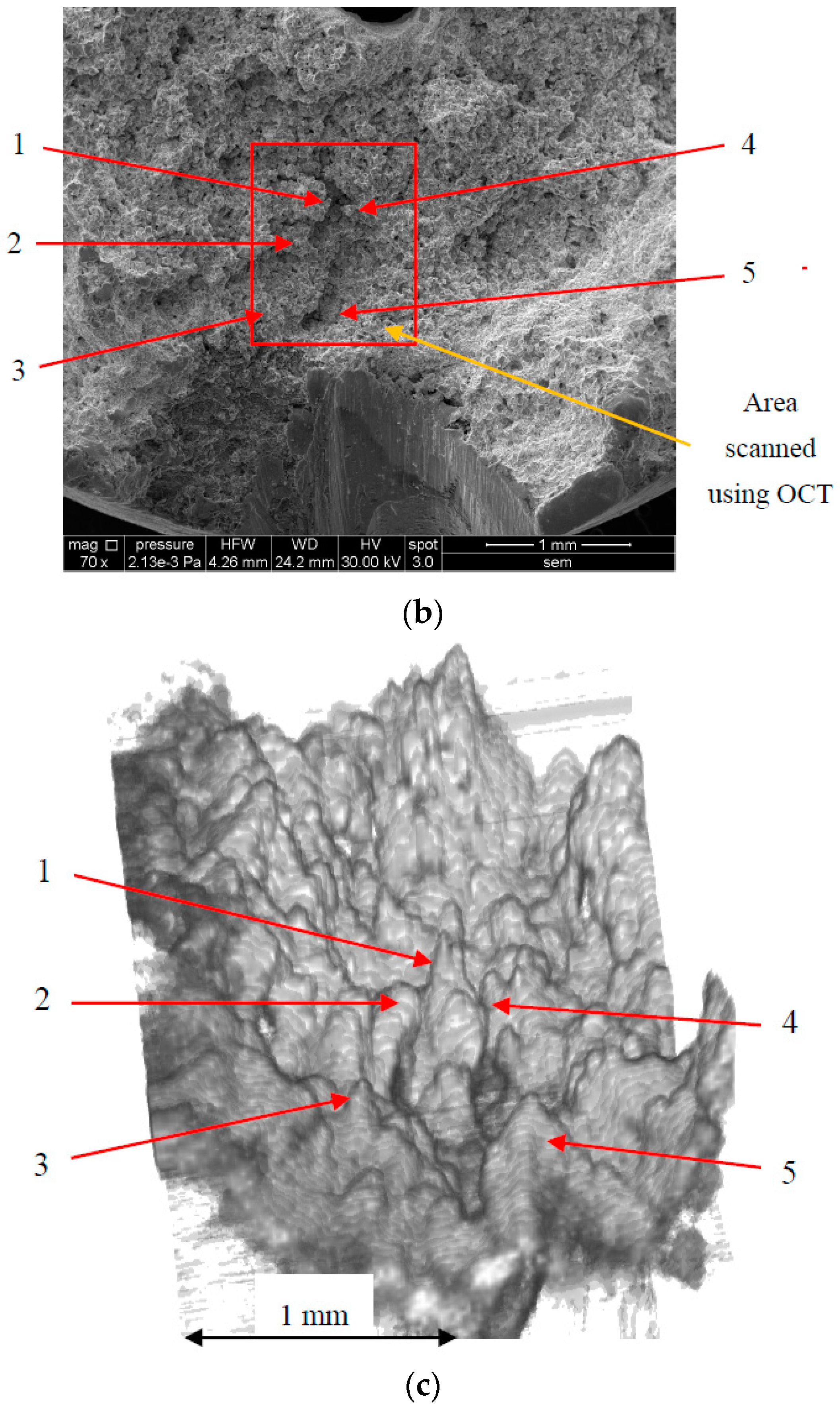
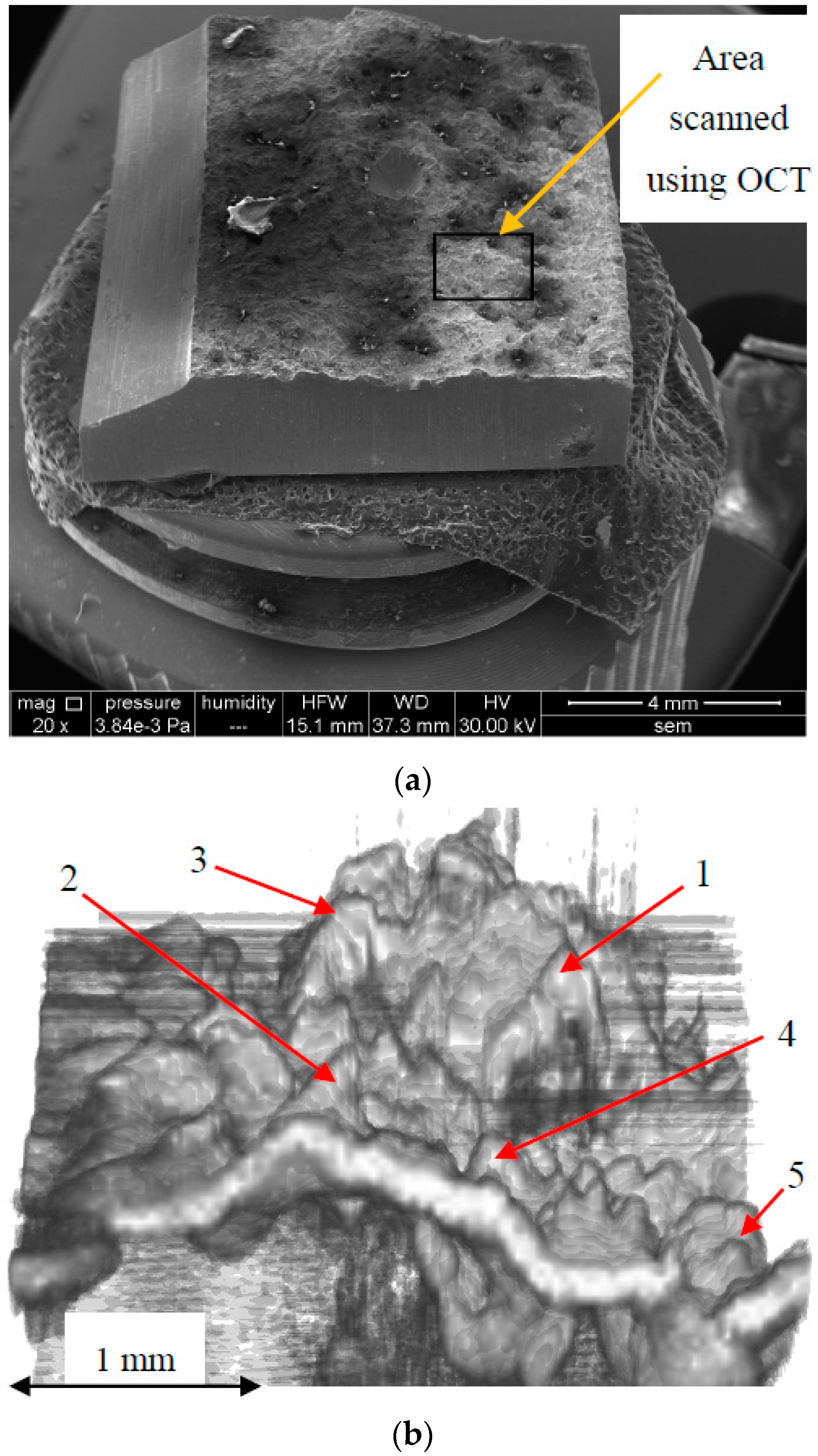

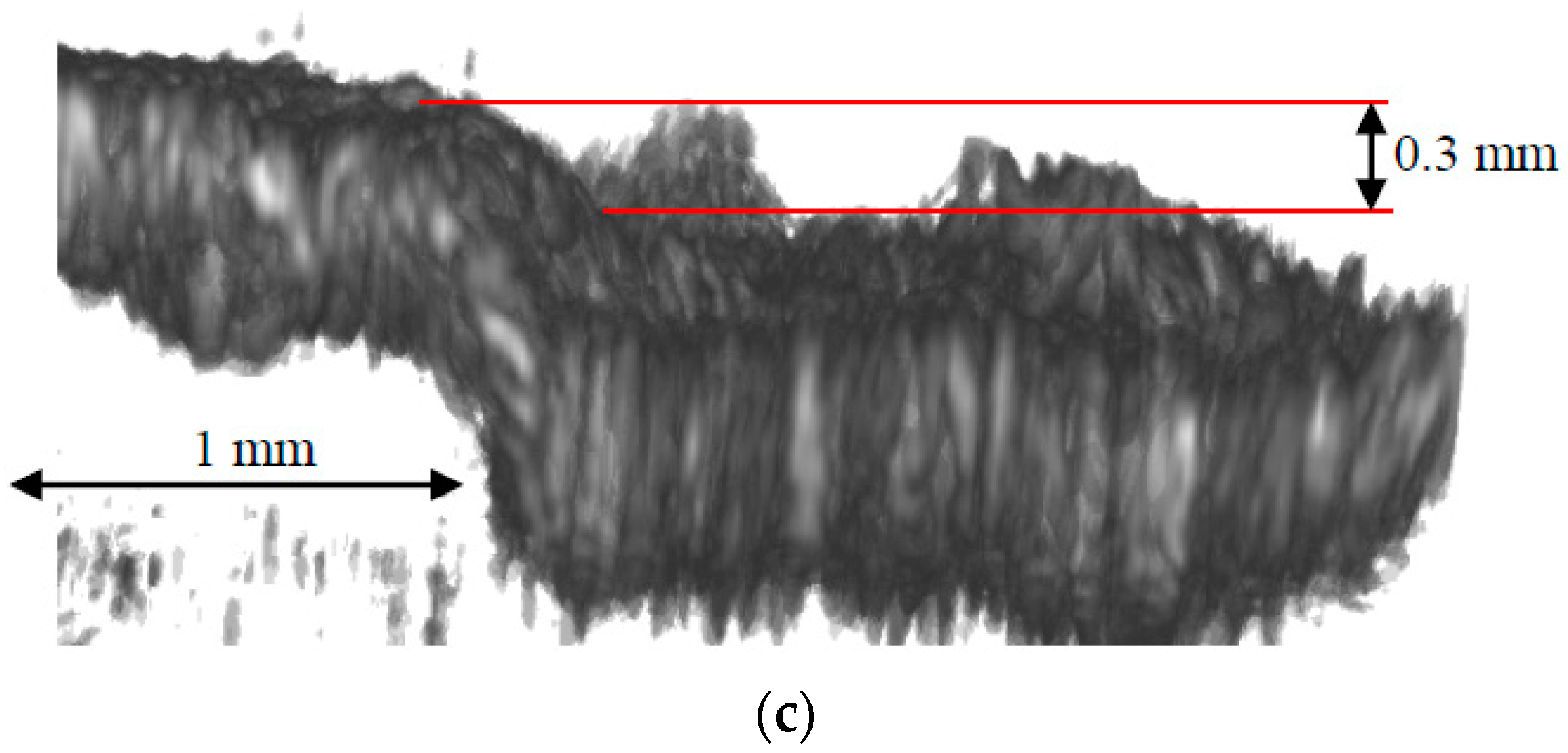
| Material | Symbol | Chemical Composition | Microstructure | Applications (Examples) |
|---|---|---|---|---|
| Low carbon steel | OL 37 OL 44 | C content ranging from 0.20 to 0.22%, Mn 0.85%, S 0.04%, P 0.05%, and Fe for the rest | Grains of ferrite and max. 25% perlite | Welded metallic parts; protection of wire meshes |
| Lamellar graphite cast iron | EN-GJL-250 (SREN 1561) | C 3.2%, Si 1.7%, P 0.3%, S 0.12%, and Fe for the rest | Ferrite, pearlite, phosphorous eutectic, and graphite grains | Castings with an average fracture strength |
| Antifriction alloy | Sn-Sb-Cu | Sb 12%, Cu 4%, Cd 1%, and Sn for the rest | A soft core of a Sn solid solution, with small amounts of dissolved Cu and Sb & with a hard phase of SnSb and Cu3Sn | Internal combustion engine bearings |
| High quality rolled steel | OLC 45 (STAS 880-88) | C 0.45%, Mn 0.7%, S 0.03%, P 0.04%, and the rest Fe | Ferrite and pearlite grains | Heat treated castings (with high rupture strength & average breaking tenacity), turbine blades, crown gears, crankshafts |
| Stainless steel | T10NiCr180 (STAS 10718-88) | C 0.007%, Si 0.78%, Mn 1.87%, Cu 1.72%, Ni 3.82%, Cr 18.11%, Mo 0.15%, Ti 0.13% | 100% austenitic microstructure | Parts resistant to high temperatures (including for automotive and aerospace) |
| Ductile cast iron | FGN 400-18 LT | C 3.43%, Si 2.30%, Mn 0.12%, S 0.09%, P 0.014% | 95% basic feritic mass, with graphite nodules | Rail wagon grease boxes |
© 2018 by the authors. Licensee MDPI, Basel, Switzerland. This article is an open access article distributed under the terms and conditions of the Creative Commons Attribution (CC BY) license (http://creativecommons.org/licenses/by/4.0/).
Share and Cite
Hutiu, G.; Duma, V.-F.; Demian, D.; Bradu, A.; Podoleanu, A.G. Assessment of Ductile, Brittle, and Fatigue Fractures of Metals Using Optical Coherence Tomography. Metals 2018, 8, 117. https://doi.org/10.3390/met8020117
Hutiu G, Duma V-F, Demian D, Bradu A, Podoleanu AG. Assessment of Ductile, Brittle, and Fatigue Fractures of Metals Using Optical Coherence Tomography. Metals. 2018; 8(2):117. https://doi.org/10.3390/met8020117
Chicago/Turabian StyleHutiu, Gheorghe, Virgil-Florin Duma, Dorin Demian, Adrian Bradu, and Adrian Gh. Podoleanu. 2018. "Assessment of Ductile, Brittle, and Fatigue Fractures of Metals Using Optical Coherence Tomography" Metals 8, no. 2: 117. https://doi.org/10.3390/met8020117





